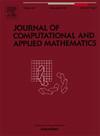模拟双边分数对流扩散淬火问题的半自适应有限差分法
IF 2.6
2区 数学
Q1 MATHEMATICS, APPLIED
Journal of Computational and Applied Mathematics
Pub Date : 2025-06-02
DOI:10.1016/j.cam.2025.116796
引用次数: 0
摘要
研究一维双边Riemann-Liouville分数阶对流扩散问题的淬火解。分数阶空间导数是离散使用加权平均近似结合标准和移位格本文章由计算机程序翻译,如有差异,请以英文原文为准。
A semi-adaptive finite difference method for simulating two-sided fractional convection–diffusion quenching problems
This paper investigates quenching solutions of an one-dimensional, two-sided Riemann–Liouville fractional order convection–diffusion problem. Fractional order spatial derivatives are discretized using weighted averaging approximations in conjunction with standard and shifted Grünwald formulas. The advective term is handled utilizing a straightforward Euler formula, resulting in a semi-discretized system of nonlinear ordinary differential equations. The conservativeness of the proposed scheme is rigorously proved and validated through simulation experiments. The study is further advanced to a fully discretized, semi-adaptive finite difference method. Detailed analysis is implemented for the monotonicity, positivity and stability of the scheme. Investigations are carried out to assess the potential impacts of the fractional order on quenching location, quenching time, and critical length. The computational results are thoroughly discussed and analyzed, providing a more comprehensive understanding of the quenching phenomena modeled through two-sided fractional order convection–diffusion problems.
求助全文
通过发布文献求助,成功后即可免费获取论文全文。
去求助
来源期刊
CiteScore
5.40
自引率
4.20%
发文量
437
审稿时长
3.0 months
期刊介绍:
The Journal of Computational and Applied Mathematics publishes original papers of high scientific value in all areas of computational and applied mathematics. The main interest of the Journal is in papers that describe and analyze new computational techniques for solving scientific or engineering problems. Also the improved analysis, including the effectiveness and applicability, of existing methods and algorithms is of importance. The computational efficiency (e.g. the convergence, stability, accuracy, ...) should be proved and illustrated by nontrivial numerical examples. Papers describing only variants of existing methods, without adding significant new computational properties are not of interest.
The audience consists of: applied mathematicians, numerical analysts, computational scientists and engineers.

 求助内容:
求助内容: 应助结果提醒方式:
应助结果提醒方式:


